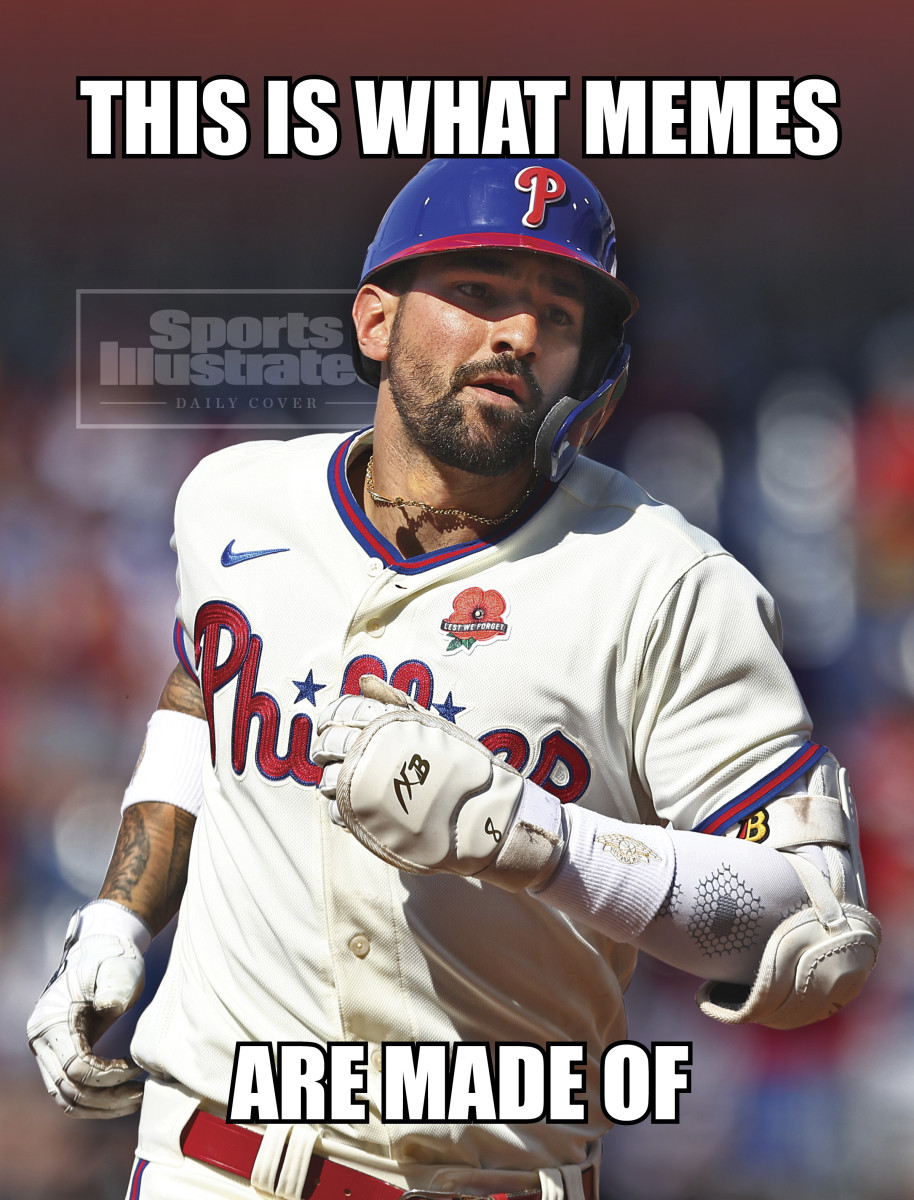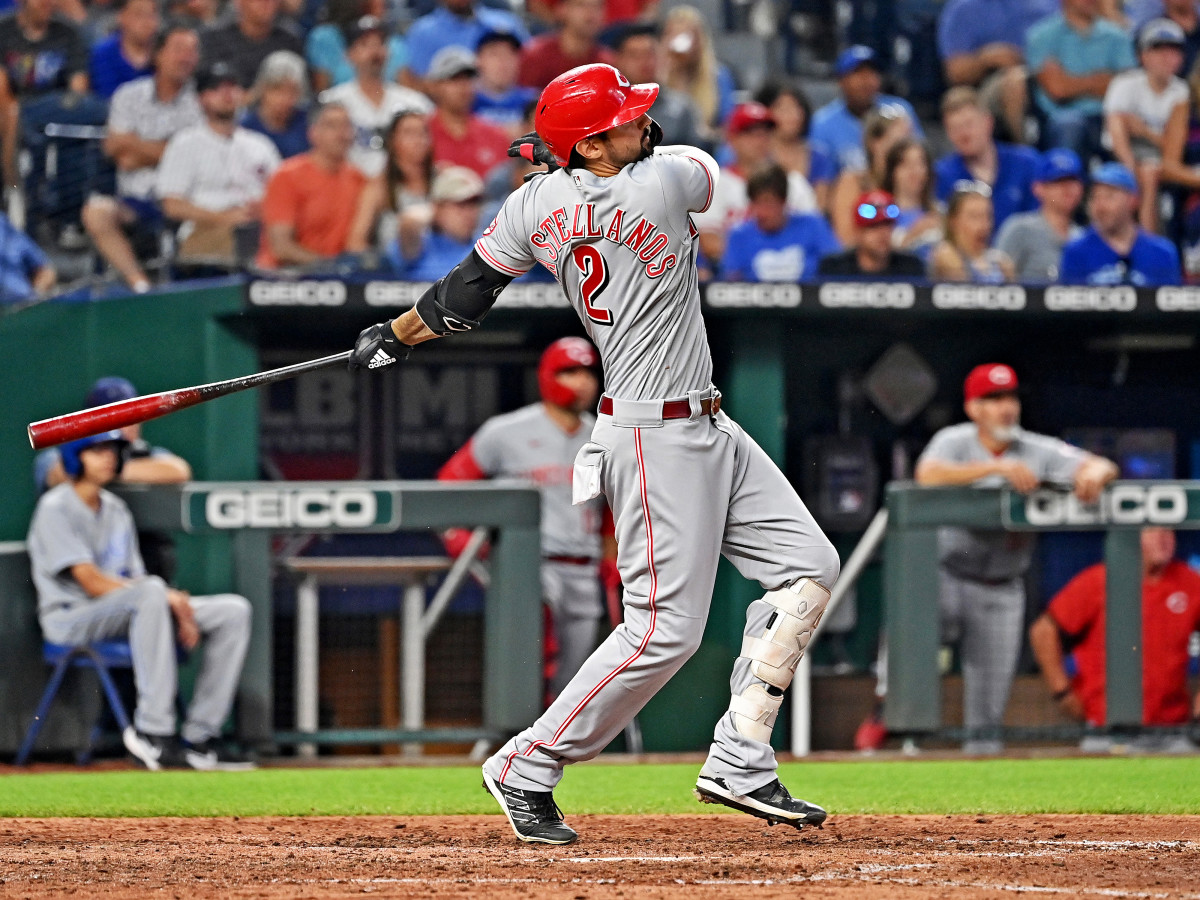The Absolute Improbability of Nick Castellanos’s Drives Into Deep Left Field
Never mind the honeyed delivery, the wit or the accumulated baseball wisdom. For all his various and sundry broadcasting gifts, Vin Scully was blessed, above all, with exquisite timing. “He may have called baseball games all those years, but he would have been a wonderful conductor or musician,” says Al Michaels, a Scully protégé dating back to his Brooklyn boyhood. “He just has this intuition for the rhythm of a game.”
The running joke was that baseball waited for Scully, not the other way around. “If Vin was in the middle of an anecdote and it was a 2–2 count,” says Ted Robinson, a longtime MLB announcer, “you could be sure the batter would foul off the next pitch, just to be sure Vin would get through his story.”
All of which is to say, it’s a good bet that Scully never much intersected with Phillies right fielder Nick Castellanos.

By now, you likely know the story. Or stories. All three of them. On Aug. 19, 2020, Castellanos was playing for the Reds. During an otherwise somnolent summer game, devoid of much significance, Cincinnati’s play-by-play man at the time, Thom Brennaman, spoke carelessly and cruelly into an open mike. During the seventh inning of the first game of a doubleheader, Brennaman didn’t realize that the broadcast was back from commercial break, and he made an anti-LGBTQ slur.
By the second game, as social media did its thing, it had become clear that Brennaman’s vile comment was going to become a problem. In what was both an apology and a clear attempt to salvage his job, Brennaman began the fifth inning with a soliloquy, “I made a comment earlier tonight that I guess went out over the air that I am deeply ashamed of,” he began to say soberly. “If I have hurt anyone out there, I can’t tell you how much I say from the bottom of my heart I’m so very, very sorry. I pride myself and think of myself as a man of faith—”
As he was winding up, so was Kansas City reliever Greg Holland, who offered a fastball to Castellanos, the batter at the time. As Brennaman continued, Castellanos’s bat collided violently with the pitch, resulting in a towering 410-foot drive. And we got this from Brennaman: “... As there’s a drive into deep left field by Castellanos, it will be a home run. And so that’ll make it a 4–0 ballgame.”
When that awkward interruption was over and as Castellanos rounded the bases, Brennaman went back to doing damage control. “I don’t know if I’m going to be putting on this headset again.”
As ESPN’s Pablo Torre puts it perfectly, “Watching Thom Brennaman break the fourth wall and then suddenly reconstruct that wall, in the same breath, remains one of the funniest things I have ever seen.”
Brennaman was, indeed, done in the Reds’ booth. He finished the apology, then turned the broadcast over to Jim Day midgame. The team suspended Brennaman that night, and he resigned a little over a month later. (He now broadcasts high school sports in the greater Cincinnati area.)
Castellanos, on the other hand, was just getting started. The next time the Reds visited Kansas City, he struck again. George Gorman, a World War II veteran and the father of Royals’ longtime equipment manager, Patrick Gorman, had recently died. Coming out of the break at the top of the seventh inning, Kansas City announcer Ryan Lefebvre began a poignant eulogy of Gorman.
Nick Castellanos, though, was batting. And he chose that precise moment to go deep with his 17th home run of the season. Here’s the call delivered by Lefebvre as it coincided with the first pitch: “We’re gonna tell you about a great man. And it’s a loss for the Royals family. …That’s a great life, 96 years. Pat, just like his dad, went to KU. He also went to Bishop Ward High School. There’s a drive into deep left center field—and there’s never a great time to eulogize someone during the broadcast, so we apologize for the timing.”
Here is the Royals broadcast of the Nick Castellanos home run.
— Nick Kirby (@Nicholaspkirby) July 6, 2021
They were eulogizing someone live on the air when it Nick went deep to left-center field.
You can not make this stuff up.
Credit to @hjodoyle for the tip. pic.twitter.com/iA2grIKY61
By this point, “a drive into deep left field by Castellanos” had become a full-fledged meme. But he wasn’t done using his bat to interrupt somber moments. Acquired by the Phillies in the offseason, Castellanos was in the box on the final Monday in May when NBC Sports Philadelphia announcer Tom McCarthy saw fit to deliver a Memorial Day tribute.
“The gold chair which will sit vacant here at Citizens Bank Park, honoring those who paid the ultimate sacrifice.” And, as if choreographed, “Castellanos rips one to deep left field. It. Is. Gone.”
A somber moment on Memorial Day is interrupted by, who else, Nick Castellanos. pic.twitter.com/F3cJv6vDTB
— Awful Announcing (@awfulannouncing) May 30, 2022
Three successive seasons. Three earnest moments. Each broken up by a Nick Castellanos home run. Unlikely. Comically unlikely. The question: just how unlikely? To try to grasp the improbability, we consulted sports statistician and NFL director of data and analytics Michael Lopez. He was kind enough to help us come up with an answer—and show his work.
The first and most basic question: How often does Castellanos hit the ball over the fence? In 2020 and ’21 he hit a combined 48 home runs in 827 plate appearances. The home run he hit on Memorial Day was his seventh home run of the ’22 season in his 200th plate appearance. That’s a home run, 5.4% of the time he steps into the box.
But that’s too broad. What Lopez rightly calls “grief announcements” came early in the plate appearance, as baseball broadcasters’ stories usually do. Over the last three seasons, through his Memorial Day blast, Castellanos hit 19 home runs on the first or second pitch of his plate appearance. Which is to say there is roughly a 2% chance that, in any given plate appearance, he would hit a home run in one of the first two pitches.
Extrapolating that, the likelihood that he would hit a home in each of those three plate appearances? It’s about one in 120,000.

But the probability really plummets when we ask: How likely was he to have three plate appearances in grief-announcement settings? To answer this question, we first need some sense of frequency. How often do broadcasters depart from the game to offer the sorts of somber soliloquies that Castellanos has an uncanny way of interrupting, the sonic equivalent of photobombing?
We put this to Ted Robinson, a veteran of calling more than 2,500 MLB games, mostly for the Giants and Twins, about how often a broadcaster would deliver a somber monologue. His estimate? “One a month. And that’s maybe,” he says. “There’s a question of What do we want to impose on an audience?” Honoring Memorial Day? Absolutely. Maybe there’s an unfortunate death of someone close to the team or an arrest you feel you have to [acknowledge]. But weeks can go by between those.”
That as a guide, a monthly “grief announcement” would equate to 10 such announcements over the last three seasons, accounting for the pandemic-shortened 2020 campaign. Given that Castellanos has played in most games over that period, one can assume that in a given game with a grief announcement he’d have a 1-in-20 chance of being at bat after that.
Extrapolating that to the 10 grief announcements, the likelihood of his being the batter after three such announcements is roughly 1.2%.
Combining Castellanos’s “early-plate-appearance home run rate” with the “odds that Castellanos would be batting when a rare grief announcement was made,” Lopez makes a back-of-the-envelope calculation. “We’d say there’s a one in 10 million chance that Castellanos would follow three grief announcements with first-two-pitch home runs. Those, literally, are Powerball odds.”

Lopez points out that the odds improve if we consider the probability that any member of the population of major league batters do what Castellanos did. The odds also improve when we consider that the grief announcement could have been made by broadcasters of either team.
Then again, the odds become longer if we want to refine this and note that Castellanos not only hit home runs, but did so to left field each time. And though it wasn’t a home run, Castellanos interrupted a fourth grief announcement earlier this season. In spring training, Blue Jays announcer Buck Martinez was awkwardly addressing the DUI arrest of Toronto pitching coach Pete Walker when Castellanos laced a single to right field—fittingly, his first at bat with the Phillies.
No sport revels in coincidence and numerology and statistical quirk quite like baseball does. Pitcher Joe Niekro’s only career home run? It came off of his brother, Phil Niekro. Of Stan Musial’s 3,630 hits, 1,815 came at home and 1,815 came on the road. Musial, incidentally, was born on Nov. 21, 1920, in tiny Donora, Pennsylvania (pop. 4,580) … the same unlikely birthplace as Ken Griffey Jr., who was born there on Nov. 21, 1969.
Castellanos’s feat, though, set the standard improbability. One in 10 million.
For perspective:
The odds of being struck by lightning in your lifetime? Per the National Weather Service, it’s 1 in 15,300.
The odds of getting bitten by a shark? One in 3.7 million.
The odds of getting struck by a meteorite? The astronomer Alan Harris once had it at 1 in 1.9 million.
The odds of being elected president of the United States? One in … 10 million.
Which is to say, the awe and amusement we all have for Castellanos’s grief-announcement Triple Crown is well-placed. With that kind of timing, when his baseball ends, he might have a second career as a baseball announcer, a successor to Vin Scully.
More MLB Coverage:
• The Phillies Are in Free Fall
• Five-Tool Newsletter: Diary of a Near-Perfect Game
• Jeremy Peña Is MLB’s Most Professional Rookie
• Welcome Back to the New Normal, Hitters
• Brett Phillips Is MLB’s Master of Fun
